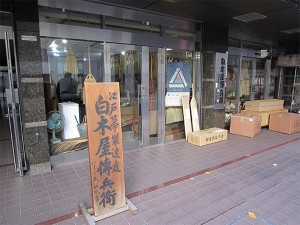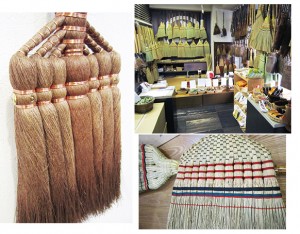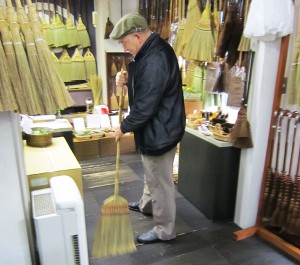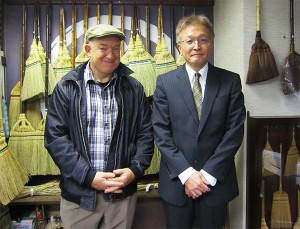【第七十回目】
白木屋傳兵衛:美しく便利な日用品「江戸ほうき」
Shirokiya Denbei: creators of the beautiful and convenient daily item ‘Edo broom’
Shirokiya Denbei: creators of the beautiful and convenient daily item ‘Edo broom’
| セインさん、今日お訪ねするのは、ほうきの専門店「白木屋傳兵衛」です。 江戸時代の終わり頃、天保元年(1830)に銀座で創業して、後に職人の町である京橋に移ってきたそうです。Thayne-san, today we’re visiting Shirokiya Denbei, a store specializing in brooms. This store was established in Ginza in 1830, around the end of the Edo Period. It later moved to the artisan district of Kyobashi. https://en.wikipedia.org/wiki/Ky%C5%8Dbashi/ |
|
 |
|
| オフィスビルが立ち並ぶ中央通りをちょっと入ったところに、老舗のほうき専門店があるということ自体が驚きです。 I’m surprised to see a traditional broom store like this in the middle of all the office buildings on Chuo-dori. | |
| (中村) | いらっしゃいませ、セインさん。白木屋傳兵衛の中村です。 Welcome, Thayne-san. I’m Nakamura of Shirokiya Denbei. |
| 中村さん。はじめまして、セインです。 お店の壁に、ほうきがずらっと掛けられていて、すごくおもしろいですね。柄が長かったり短かったり、箒の形もいろいろで、ものすごく凝った編み込みがされている工芸品のようなものまであるんですね。 Nice to meet you, Nakamura-san. I’m David Thayne. The walls of the store are lined with brooms. It’s fascinating. There are long-handled brooms, short-handled brooms, brooms in different shapes, and extremely elaborately woven brooms that look like works of art. |
|
 |
|
| (中村) | どうぞ、ゆっくりご覧ください。そして、ぜひいろいろ持って重さを感じたり、掃き比べたりしてみてください。 Please, take a look around. Make sure you try holding the brooms to feel their weight and compare how they sweep. |
| あっ。同じ大きさのほうきでも、実際に使ってみるとずいぶん感じが違いますね! Ah! These brooms are the same size, but they feel completely different! |
|
| (中村) | はい。ほうきは使う人の背丈や、使う場所が畳の部屋か洋室か、庭か、といったことで最適なものが変わりますから、一番いいほうき、というのはありません。使う人や用途によって選ぶほうきが変わるんです。 That’s right. There’s no best broom, because it depends on things like the user’s height, or if it’s being used in a tatami room, a Western-style room or a garden. The best broom depends on the person and the purpose. ただ、選ぶ時に一番大事なポイントになるのは、重さのバランスがよいかどうかです。同じ長さのほうきでも、重心が上の方にあるものは振ると重く感じます。ほうきの先の方に重心を感じるものは軽くて、いくら掃いても疲れません。 But the most important thing to consider when choosing a broom is whether or not the balance is good. Even with brooms of the same length, people who have a higher center of gravity will feel that it’s heavy to use. The person using the broom should feel that it’s light so they won’t get tired no matter how much sweeping they do. |
| なるほど! 重心が下の方にあるものは、大きなほうきでもバランスがいいので、軽く振れて、 スイスイと掃けますね! I see! For a person with a lower center of gravity, a larger broom has better balance so it’s light and sweeps really smoothly. |
|
 Thayne-san trying out a broom Thayne-san trying out a broom |
|
| (中村) | はい。そこが肝心なところです。毎日使う日用品ですから、使い勝手がよいこと。そして、丈夫で長持ちすることも大事です。 Yes. That’s the fundamental point. It’s something that’s used everyday, so it has to be user-friendly. It’s also important that it’s durable and can last a long time. |
| そもそも、ほうきは、いつ頃から使われていたのですか? When did people originally start using these brooms? |
|
| (中村) | 奈良の正倉院には、孝謙天皇が蚕部屋を掃いて豊作を祈ったと伝えられているほうきが 納められていますが、ほうきにはそういう呪術的な意味合いもあったようなのです。妊婦さんのおなかを新しいほうきでなでると安産になるというおまじないも戦前までは見られました。 The broom that Empress Koken is said to have used to sweep a silkworm room and pray for a bountiful harvest is kept in Nara’s Shosou-in treasure house, but it seems like brooms have always had those kinds of supernatural connotations. https://en.wikipedia.org/wiki/Empress_K%C5%8Dken https://en.wikipedia.org/wiki/Sh%C5%8Ds%C5%8Din Up until around the start of World War II, you could also see people sweeping a new broom over a pregnant woman’s stomach as good luck for an easy birth. |
| 日用品なのに、神がかった力もある!……ほうきって不思議な道具ですね。 材料は何が使われているのですか? It’s an everyday item, but it also has spiritual powers! Brooms sure are curious tools. What kind of materials are used to make them? |
|
| (中村) | シュロや竹や藁などいろいろな植物がほうきの材料として使われていますが、座敷用の「江戸ほうき」の材料はホウキモロコシという草です。 Various materials like hemp palm, bamboo and straw are used, but for Edo brooms that are used in tatami rooms, we use a plant called broom corn. https://en.wikipedia.org/wiki/Tatami 日本で庶民の家に畳が普及したのは江戸中期以降ですが、それまで使われていたホウキグサやシュロで作ったほうきは、畳に使うには堅かったり、粉が出たりと不向きでした。そこで目をつけられたのがホウキモロコシです。この植物はあたりが柔らかで、しかもコシがあるので、さっと掃き出すことができる。そのホウキモロコシを使ったほうきを「江戸ほうき」と名付けて、今日まで商ってきたのが当店です。 Tatami became common in everyday people’s houses from the middle of the Edo Period, but the brooms made of hemp palm and scoparia grass used up until then were unsuitable for use on tatami because they were too stiff and left granules everywhere. Therefore, we started using broom corn. It’s a soft plant and it’s also springy, so you can sweep very quickly. We started calling the brooms made of broom corn Edo brooms, and that’s been our trade ever since. https://en.wikipedia.org/wiki/Edo_period 江戸ほうきは弾力があるので、部屋の隅っこも段差も上手に掃けますし、細かいゴミもよく かき出します。さらに、毎日掃いていくと畳にツヤがでます。また、電気掃除機のようにホコリを舞い上げることもありませんし、電気代もかからない。毎日使っても5~6年は持ち、穂先が痛んできたら板の間、土間、庭ぼうき……と使い続けられる。そして、捨てる時にお金もかかりません(笑)。 Edo brooms are very flexible, so they’re great for reaching into corners and sweeping steps as well as picking up small pieces of dirt. If you sweep your tatami with them every day, it will bring out the luster. They also don’t kick up dust like a vacuum cleaner does, and there’s no electricity cost. Even if you use one everyday, it will last for five or six years. Even if the bristle tips become damaged, you can continue to use it on wooden floors, dirt floors or outside in the garden. Also it doesn’t cost anything to dispose of, unlike vacuum cleaners! |
| 材料のホウキモロコシはどこで採れるのですか? Where does the broom corn come from? |
|
| (中村) | うちでは、筑波山のふもとの農家に依頼して作ってもらっていますが、国産品は希少です。多くは海外のもので、タイの北部などで栽培されているものを輸入しています。 In our case, we asked farmers living at the foot of Mount Tsukuba to grow it for us, but domestically produced broom corn is scarce. Lots of it comes from overseas. We import it from places like northern Thailand where it’s cultivated. |
| ほうきを作る職人さんは減っていませんか? 老齢化が進んでいるとか。 Is the number of craftsmen making brooms decreasing, what with the aging society problem? |
|
| (中村) | いまのところ、ウチは大丈夫です。20代、30代の職人さんもいますし、女性の若い職人さんもいて、みんなよくやってくれています。 At the moment, we’re doing okay. We have craftsmen in their 20s and 30s as well as some young women. Everyone is working well. |
| それはすばらしい。 That’s wonderful. |
|
| (中村) | ただ、ほうき作りで一番難しいのは、材料の見極めなのです。言い換えると、江戸ほうきは材料がすべて。ですから、一番よい作り手が、一番の目利きでもあるんです。 ただ、材料を選ぶ目を養うには、長い経験を必要とします。それを代々伝えてきたのが、白木屋傳兵衛という店、ということなんです。 The most difficult thing about making brooms is choosing the right materials. To put it another way, the materials are what make the Edo broom. Therefore, there are great craftsmen, but there are also great connoisseurs. A lot of experience is necessary to gain an eye for choosing materials. That’s something that’s handed down through the generations and is the fundamental part of what we do at Shirokiya Denbei. |
| なるほど! この店の本当のすごさが少しわかってきました。 I see! I’m starting to understand just how amazing this shop is. |
|
| (中村) | 実は、戦後、ほうきが悪者になった時代がありました。電気掃除機が各家庭に入ってくると同時に、ほうきが前時代的な古臭いもの、劣っているものとみられるようになったのです。ほうきを扱う店はどんどん減って、我が家ももう終わりか、と案じました。 Actually, the post-war years were a bad time for the broom industry. At the same time as vacuum cleaners were starting to be used, brooms came to be seen as old-fashioned and inferior. The number of shops dealing with brooms became fewer and fewer, and we were worried that our shop might also not survive. ところが、やがて店に、ご家族にアレルギーを持っているという方がぽつりぽつりと訪ねてこられるようになりました。電気掃除機のようにホコリを舞い上げないから、と、ほうきを買い求めに来られるのです。そういう方々には、ほうきの使い方、掃き方から丁寧に教えることにしました。 However, eventually we started to get new customers who had allergies. Since brooms don’t kick up dust the way that vacuum cleaners do, there started to be a demand for brooms once more. We decided to show these people the most effective way to use a broom. そうこうしているうちに、今度は若い人がほうきに注目してくれるようになりました。エコで健康的だし、置き場所もとらない。第一、ゴミを見つけたら、パッと出してサッと掃いたらおしまい、便利でいいと。 Meanwhile, brooms started to catch the attention of young people. They’re eco-friendly, hygienic and don’t take up much space. The best thing is that when you find some dirt, you can quickly get out your broom and sweep it up there and then, and you’re done! It’s very convenient. |
| 生まれた時に家に電気掃除機があった世代にとって、電気掃除機は、あこがれの品でもなんでもない。かえって、単純明快にほうきの利点・良さがわかるのかもしれませんね。そして美しさも。 For people who were born after vacuum cleaners were a common thing, they aren’t really considered to be valuable objects. Such people can appreciate the advantages–and beauty–of simple tools like brooms. |
|
| 次は、海外の人にも、ほうきのすばらしさを伝えたいですね。 I’d like to let people overseas know how wonderful these brooms are. |
|
| (中村) | セインさん、ぜひよろしくお願いします。 Please do, Thayne-san. |
| はい! 今日はありがとうございました! I will! Thank you for your time today! |
|
 |
|
| (文)太田美代 (英訳)デイビッド・A・セイン |
 1959年、米国生まれ。証券会社勤務を経て来日し、翻訳・通訳など多岐にわたって活躍。豊富な教授経験を生かし、数多くの英語関係書籍を執筆。近著に『日本人のチョットへんな英語』(アスコム)、『超入門シャドーイング』(主婦の友社)、日本人が使いすぎる英語(PHP文庫)など多数。 下町の魅力に魅了され、自身が代表を務める英語関連のコンテンツ会社のエートゥーゼットのオフィスを根津に構えている。英会話本の執筆をしながら、東京・文京区根津と春日にあるエートゥーゼット英語学校の校長も務める。 http://www.smartenglish.co.jp/
1959年、米国生まれ。証券会社勤務を経て来日し、翻訳・通訳など多岐にわたって活躍。豊富な教授経験を生かし、数多くの英語関係書籍を執筆。近著に『日本人のチョットへんな英語』(アスコム)、『超入門シャドーイング』(主婦の友社)、日本人が使いすぎる英語(PHP文庫)など多数。 下町の魅力に魅了され、自身が代表を務める英語関連のコンテンツ会社のエートゥーゼットのオフィスを根津に構えている。英会話本の執筆をしながら、東京・文京区根津と春日にあるエートゥーゼット英語学校の校長も務める。 http://www.smartenglish.co.jp/







